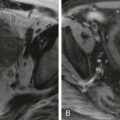Chapter Outline
- Table 101-1.
- Table 101-2.
- Table 101-3.
- Table 101-4.
- Table 101-5.
Cystic Pancreatic Masses Within and Adjacent to Pancreas Pseudocyst
- Table 101-6.
Pseudocysts Versus Cystic Pancreatic Neoplasms: Differentiating Features
- Table 101-7.
- Table 101-1.
- Table 101-8.
- Table 101-9.
- Table 101-8.
Computed Tomography and Magnetic Resonance Imaging
- Table 101-10.
Hypervascular Pancreatic Masses
- Table 101-11.
Magnetic Resonance Pattern Recognition: Focal Pancreatic Lesions
- Table 101-10.
- Table 101-12.
- Table 101-12.
Imaging Findings in Specific Pancreatic Diseases
- Table 101-13.
- Table 101-14.
- Table 101-15.
Pancreatic Ductal Adenocarcinoma
- Table 101-16.
- Table 101-17.
- Table 101-13.
Imaging Abnormalities
TABLE 101-1
Pancreatic Calcification
| COMMON |
| Volume averaging with vascular calcification |
| Chronic pancreatitis |
| Alcoholic (20%-50%) |
| Hereditary (35%-60%) |
| Biliary (2%) |
| Idiopathic |
| Common bile duct stone |
| UNCOMMON |
| Acute pancreatitis with saponification |
| Serous cystadenoma (sunburst, 33%) |
| Mucinous cystadenoma or cystadenocarcinoma (rounded) |
| Pseudocyst |
| Islet cell tumor |
| Metastasis |
| Cystic fibrosis |
| Kwashiorkor |
| Cavernous lymphangioma |
| Adenocarcinoma (2%) |
| Intraparenchymal hemorrhage |
| Hyperparathyroidism |
| After infarct, abscess |
| After rupture of pancreatic neoplasm |
| Hemochromatosis |
TABLE 101-2
Focal Pancreatic Mass
| INFLAMMATORY |
| Acute pancreatitis |
| Chronic pancreatitis |
| Groove pancreatitis |
| Pseudocyst |
| Abscess |
| NEOPLASTIC—PRIMARY |
| Ductal adenocarcinoma |
| Intraductal papillary mucinous neoplasm |
| Islet cell tumors |
| Serous cystadenoma |
| Mucinous cystadenoma |
| Mucinous cystadenocarcinoma |
| Lymphoma |
| Metastases |
| Normal anatomic variant |
| Peripancreatic disease |
| Aneurysms |
| Thrombosed vessels |
TABLE 101-3
Dilated Pancreatic Duct
| Chronic pancreatitis |
| Pancreatic or ampullary mass |
| Distal common duct stone |
| Intraductal pancreatic mucinous neoplasm |
| Aging |
| NATURE OF DILATION |
| Suggesting Pancreatitis |
| Irregular dilation |
| Calculi |
| Duct occupies >50% of anteroposterior gland diameter |
| Suggesting Neoplasm |
| Smooth and beaded appearance |
| Duct occupies >50% of anteroposterior gland diameter |
TABLE 101-4
Gas in Pancreatic Duct
| After endoscopic retrograde cholangiopancreatography |
| Prior papillotomy |
| Patulous vaterian sphincter |
| Duodenal diverticulum |
| Enteropancreatic fistula (spontaneous, surgical) |
| Abscess |
TABLE 101-5
Cystic Pancreatic Masses Within and Adjacent to Pancreas Pseudocyst
| Cystic biliary and pancreatic duct anomalies |
| After inflammation |
| After trauma |
| After surgery |
| Idiopathic |
| CYSTIC NEOPLASMS |
| Ductal cancer |
| Cystadenoma |
| Cystadenocarcinoma |
| Leiomyosarcoma |
| Dermoid |
| Vascular |
| Lymphangioma |
| Hemangioma |
| RETENTION (POSTOBSTRUCTIVE) |
| Pancreatic cancer |
| Pancreatic lithiasis |
| Acute and chronic pancreatitis |
| Cholelithiasis and cholecystitis |
| Echinococcus infection |
| Ascaris infection |
| Clonorchis sinensis infection |
| CONGENITAL |
| Simple |
| Polycystic diseases |
| Cystic fibrosis |
| Duodenal enteric (duplication) |
| Intrapancreatic choledochal cyst |
| Cystic biliary and pancreatic duct anomalies |
TABLE 101-6
Pseudocysts Versus Cystic Pancreatic Neoplasms: Differentiating Features
| Feature | Cystic Neoplasm | Pseudocyst |
|---|---|---|
| Number of cysts | Multiple | Single |
| Common site | Body, tail | Head |
| Wall calcification | 10% | Frequent |
| Wall thickness | >1 cm | <1 cm |
TABLE 101-7
Pancreatic Lipomatosis
| Obstruction of the main pancreatic duct |
| Age—atherosclerosis of elderly |
| Obesity |
| Steroid therapy |
| Cushing’s syndrome |
| Cystic fibrosis |
| Shwachman-Diamond syndrome |
| Malnutrition |
| Hemochromatosis |
| Viral infection |
| Obstruction of the main pancreatic duct |
Ultrasound
TABLE 101-8
Hypoechoic Pancreatic Masses
| Focal pancreatitis |
| Lymphoma |
| Carcinoma |
| Metastases |
Stay updated, free articles. Join our Telegram channel

Full access? Get Clinical Tree








